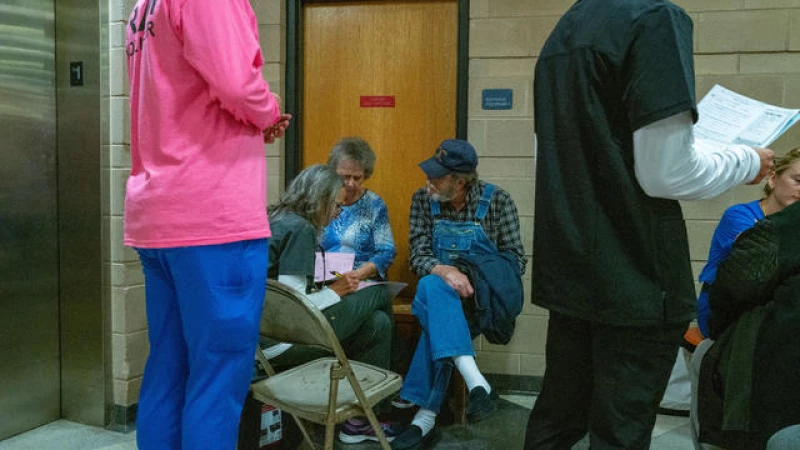During Matthew Roach's tenure as vital statistics manager for the Arizona Department of Health Services and his previous work in the epidemiology program, a concerning trend in mortality rates has caught the attention of rural health experts.
Roach's observations revealed a growing disparity in mortality rates between residents of rural areas and their urban counterparts in Arizona.
Although the health gap between rural and urban Americans has been well-documented, a recent report from the Department of Agriculture's Economic Research Service highlighted an alarming increase in this gap over the past few decades. Researchers from the USDA found that individuals in rural areas aged 25 to 54 are experiencing significantly higher rates of natural-cause deaths, such as chronic diseases and cancer, compared to their urban peers in the same age group. The study did not take into account deaths caused by external factors like suicide or accidental overdose.
The analysis was based on data from the Centers for Disease Control and Prevention covering two three-year periods: 1999 to 2001 and 2017 to 2019. In 1999, the natural-cause mortality rate for individuals aged 25 to 54 in rural areas was only 6% higher than that of urban residents in the same age range. However, by 2019, this gap had widened to 43%.
The researchers found the expanding gap was driven by rapid growth in the number of women living in rural places who succumb young to treatable or preventable diseases. In the most rural places, counties without an urban core population of 10,000 or more, women in this age group saw an 18% increase in natural-cause mortality rates during the study period, while their male peers experienced a 3% increase.
Within the prime working-age group, cancer and heart disease were the leading natural causes of death for both men and women in both rural and urban areas. Among women, the incidence of lung disease in remote parts of the nation grew the most when compared with rates in urban areas, followed by hepatitis. Pregnancy-related deaths also played a role, accounting for the highest rate of natural-cause mortality growth for women ages 25 to 54 in rural areas.
The negative trends for rural non-Hispanic American Indian and Alaska Native people were especially pronounced. The analysis shows Native Americans 25 to 54 years old had a 46% natural-cause mortality rate increase over those two decades. Native women had an even greater mortality rate jump, 55%, between the two studied time periods, while the rate for non-Hispanic White women went up 23%.
The rural-urban gap grew in all regions across the nation but was widest in the South.
The increased mortality rates are an indicator of worsening population health, the study authors noted, which can harm local economies and employment.
As access to and quality of health services in rural areas continue to erode, rural health experts said, the USDA findings should spur stronger policies focused on rural health.
The disparity warrants greater attention from state and national leaders, Morgan said.
The study does not address causes for the increase in mortality rates, but the authors note that differences in health care resources could compromise the accessibility, quality, and affordability of care in rural areas. Hospitals in small and remote communities have long struggled, and continued closures or conversions limit health care services in many places. The authors note that persistently higher rates of poverty, disability, and chronic disease in rural areas, compounded by fewer physicians per capita and the closure of hospitals, affect community health.
Roach said his past job as an epidemiologist included working with social vulnerability indexes, which factor in income, race, education, and access to resources like housing to get a sense of a community's resilience against adverse health outcomes. A map of Arizona shows that rural counties and reservations have some of the highest vulnerability rankings.
Janice C. Probst, a retired professor at the University of South Carolina whose work focused on rural health, said many current rural health efforts are focused on sustaining hospitals, which she noted are essential sources of health care. But she said that may not be the best way to address the inequities.
The disparities among demographics stood out to Probst, along with something else. She said the states with the highest rates of natural-cause mortality in rural areas included South Carolina, Mississippi, Georgia, Alabama, and others that have not expanded Medicaid, the joint federal and state health insurance program for low-income people, though there are efforts to expand it in some states, particularly Mississippi.
It's an observation the USDA researchers make as well.
"Regionally, differences in State implementation of Medicaid expansion under the 2010 Affordable Care Act could have increased implications for uninsured rural residents in States without expansions by potentially influencing the frequency of medical care for those at risk," they wrote.
Two-thirds of individuals residing in states that have not expanded Medicaid express a desire for their state to expand the health insurance program, as per KFF polling data.
The study, as highlighted by Morgan, focused on fatalities that occurred before the COVID-19 outbreak, which had a severe impact on rural regions.
"The onset of COVID significantly altered the landscape of public health in rural America," Morgan stated. "I am hopeful that this will urge Congress to instruct the CDC to investigate rural-urban life expectancies during and post COVID, in order to comprehend the nationwide scenario better."
In Arizona, COVID was identified as the primary cause of death for individuals aged 45 to 64 in both rural and urban areas in 2021, according to Roach.
KFF Health News is a national newsroom that produces in-depth journalism about health issues and is one of the core operating programs at KFF — the independent source for health policy research, polling, and journalism.







